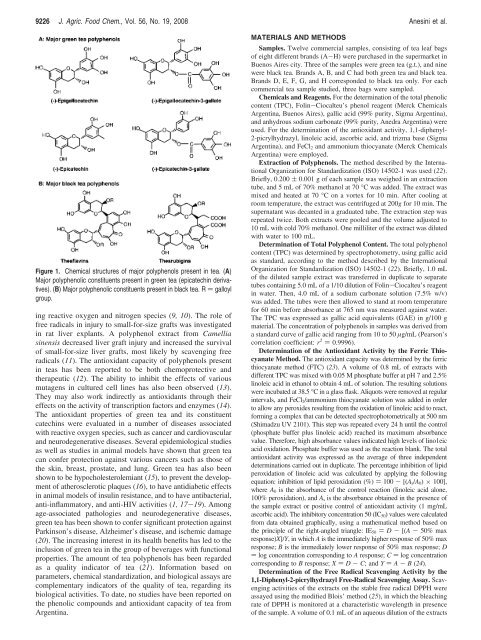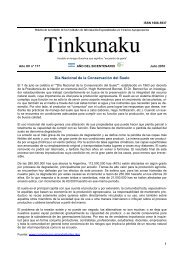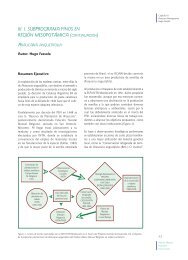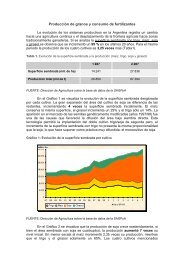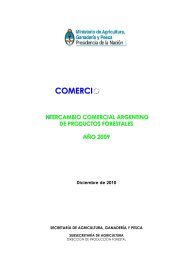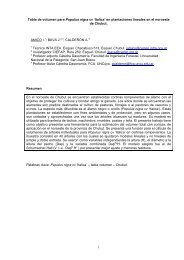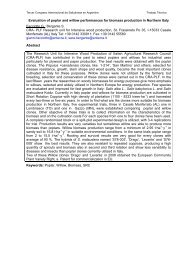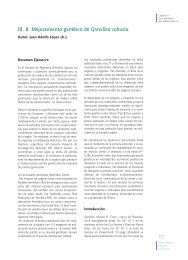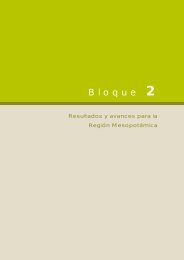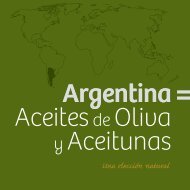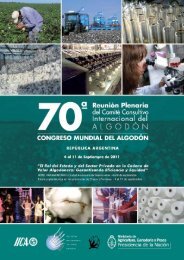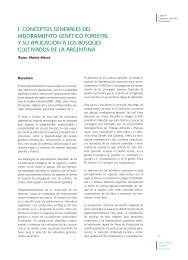Total Polyphenol Content and Antioxidant Capacity of Commercially ...
Total Polyphenol Content and Antioxidant Capacity of Commercially ...
Total Polyphenol Content and Antioxidant Capacity of Commercially ...
You also want an ePaper? Increase the reach of your titles
YUMPU automatically turns print PDFs into web optimized ePapers that Google loves.
9226 J. Agric. Food Chem., Vol. 56, No. 19, 2008 Anesini et al.Figure 1. Chemical structures <strong>of</strong> major polyphenols present in tea. (A)Major polyphenolic constituents present in green tea (epicatechin derivatives).(B) Major polyphenolic constituents present in black tea. R ) galloylgroup.ing reactive oxygen <strong>and</strong> nitrogen species (9, 10). The role <strong>of</strong>free radicals in injury to small-for-size grafts was investigatedin rat liver explants. A polyphenol extract from Camelliasinensis decreased liver graft injury <strong>and</strong> increased the survival<strong>of</strong> small-for-size liver grafts, most likely by scavenging freeradicals (11). The antioxidant capacity <strong>of</strong> polyphenols presentin teas has been reported to be both chemoprotective <strong>and</strong>therapeutic (12). The ability to inhibit the effects <strong>of</strong> variousmutagens in cultured cell lines has also been observed (13).They may also work indirectly as antioxidants through theireffects on the activity <strong>of</strong> transcription factors <strong>and</strong> enzymes (14).The antioxidant properties <strong>of</strong> green tea <strong>and</strong> its constituentcatechins were evaluated in a number <strong>of</strong> diseases associatedwith reactive oxygen species, such as cancer <strong>and</strong> cardiovascular<strong>and</strong> neurodegenerative diseases. Several epidemiological studiesas well as studies in animal models have shown that green teacan confer protection against various cancers such as those <strong>of</strong>the skin, breast, prostate, <strong>and</strong> lung. Green tea has also beenshown to be hypocholesterolemiant (15), to prevent the development<strong>of</strong> atherosclerotic plaques (16), to have antidiabetic effectsin animal models <strong>of</strong> insulin resistance, <strong>and</strong> to have antibacterial,anti-inflammatory, <strong>and</strong> anti-HIV activities (1, 17-19). Amongage-associated pathologies <strong>and</strong> neurodegenerative diseases,green tea has been shown to confer significant protection againstParkinson’s disease, Alzheimer’s disease, <strong>and</strong> ischemic damage(20). The increasing interest in its health benefits has led to theinclusion <strong>of</strong> green tea in the group <strong>of</strong> beverages with functionalproperties. The amount <strong>of</strong> tea polyphenols has been regardedas a quality indicator <strong>of</strong> tea (21). Information based onparameters, chemical st<strong>and</strong>ardization, <strong>and</strong> biological assays arecomplementary indicators <strong>of</strong> the quality <strong>of</strong> tea, regarding itsbiological activities. To date, no studies have been reported onthe phenolic compounds <strong>and</strong> antioxidant capacity <strong>of</strong> tea fromArgentina.MATERIALS AND METHODSSamples. Twelve commercial samples, consisting <strong>of</strong> tea leaf bags<strong>of</strong> eight different br<strong>and</strong>s (A-H) were purchased in the supermarket inBuenos Aires city. Three <strong>of</strong> the samples were green tea (g.t.), <strong>and</strong> ninewere black tea. Br<strong>and</strong>s A, B, <strong>and</strong> C had both green tea <strong>and</strong> black tea.Br<strong>and</strong>s D, E, F, G, <strong>and</strong> H corresponded to black tea only. For eachcommercial tea sample studied, three bags were sampled.Chemicals <strong>and</strong> Reagents. For the determination <strong>of</strong> the total phenoliccontent (TPC), Folin-Ciocalteu’s phenol reagent (Merck ChemicalsArgentina, Buenos Aires), gallic acid (99% purity, Sigma Argentina),<strong>and</strong> anhydrous sodium carbonate (99% purity, Anedra Argentina) wereused. For the determination <strong>of</strong> the antioxidant activity, 1,1-diphenyl-2-picrylhydrazyl, linoleic acid, ascorbic acid, <strong>and</strong> trizma base (SigmaArgentina), <strong>and</strong> FeCl 2 <strong>and</strong> ammonium thiocyanate (Merck ChemicalsArgentina) were employed.Extraction <strong>of</strong> <strong>Polyphenol</strong>s. The method described by the InternationalOrganization for St<strong>and</strong>ardization (ISO) 14502-1 was used (22).Briefly, 0.200 ( 0.001 g <strong>of</strong> each sample was weighed in an extractiontube, <strong>and</strong> 5 mL <strong>of</strong> 70% methanol at 70 °C was added. The extract wasmixed <strong>and</strong> heated at 70 °C on a vortex for 10 min. After cooling atroom temperature, the extract was centrifuged at 200g for 10 min. Thesupernatant was decanted in a graduated tube. The extraction step wasrepeated twice. Both extracts were pooled <strong>and</strong> the volume adjusted to10 mL with cold 70% methanol. One milliliter <strong>of</strong> the extract was dilutedwith water to 100 mL.Determination <strong>of</strong> <strong>Total</strong> <strong>Polyphenol</strong> <strong>Content</strong>. The total polyphenolcontent (TPC) was determined by spectrophotometry, using gallic acidas st<strong>and</strong>ard, according to the method described by the InternationalOrganization for St<strong>and</strong>ardization (ISO) 14502-1 (22). Briefly, 1.0 mL<strong>of</strong> the diluted sample extract was transferred in duplicate to separatetubes containing 5.0 mL <strong>of</strong> a 1/10 dilution <strong>of</strong> Folin-Ciocalteu’s reagentin water. Then, 4.0 mL <strong>of</strong> a sodium carbonate solution (7.5% w/v)was added. The tubes were then allowed to st<strong>and</strong> at room temperaturefor 60 min before absorbance at 765 nm was measured against water.The TPC was expressed as gallic acid equivalents (GAE) in g/100 gmaterial. The concentration <strong>of</strong> polyphenols in samples was derived froma st<strong>and</strong>ard curve <strong>of</strong> gallic acid ranging from 10 to 50 µg/mL (Pearson’scorrelation coefficient: r 2 ) 0.9996).Determination <strong>of</strong> the <strong>Antioxidant</strong> Activity by the Ferric ThiocyanateMethod. The antioxidant capacity was determined by the ferricthiocyanate method (FTC) (23). A volume <strong>of</strong> 0.8 mL <strong>of</strong> extracts withdifferent TPC was mixed with 0.05 M phosphate buffer at pH 7 <strong>and</strong> 2.5%linoleic acid in ethanol to obtain 4 mL <strong>of</strong> solution. The resulting solutionswere incubated at 38.5 °C in a glass flask. Aliquots were removed at regularintervals, <strong>and</strong> FeCl 2/ammonium thiocyanate solution was added in orderto allow any peroxides resulting from the oxidation <strong>of</strong> linoleic acid to react,forming a complex that can be detected spectrophotometrically at 500 nm(Shimadzu UV 2101). This step was repeated every 24 h until the control(phosphate buffer plus linoleic acid) reached its maximum absorbancevalue. Therefore, high absorbance values indicated high levels <strong>of</strong> lino1eicacid oxidation. Phosphate buffer was used as the reaction blank. The totalantioxidant activity was expressed as the average <strong>of</strong> three independentdeterminations carried out in duplicate. The percentage inhibition <strong>of</strong> lipidperoxidation <strong>of</strong> linoleic acid was calculated by applying the followingequation: inhibition <strong>of</strong> lipid peroxidation (%) ) 100 - [(A s/A 0) × 100],where A 0 is the absorbance <strong>of</strong> the control reaction (linoleic acid alone,100% peroxidation), <strong>and</strong> A s is the absorbance obtained in the presence <strong>of</strong>the sample extract or positive control <strong>of</strong> antioxidant activity (1 mg/mLascorbic acid). The inhibitory concentration 50 (IC 50) values were calculatedfrom data obtained graphically, using a mathematical method based onthe principle <strong>of</strong> the right-angled triangle: IE 50 ) D - [(A - 50% maxresponse)X]/Y, in which A is the immediately higher response <strong>of</strong> 50% maxresponse; B is the immediately lower response <strong>of</strong> 50% max response; D) log concentration corresponding to A response; C ) log concentrationcorresponding to B response; X ) D - C; <strong>and</strong> Y ) A - B (24).Determination <strong>of</strong> the Free Radical Scavenging Activity by the1,1-Diphenyl-2-picrylhydrazyl Free-Radical Scavenging Assay. Scavengingactivities <strong>of</strong> the extracts on the stable free radical DPPH wereassayed using the modified Blois’ method (25), in which the bleachingrate <strong>of</strong> DPPH is monitored at a characteristic wavelength in presence<strong>of</strong> the sample. A volume <strong>of</strong> 0.1 mL <strong>of</strong> an aqueous dilution <strong>of</strong> the extracts


